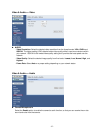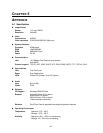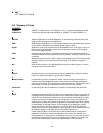
-46-
E
Enterprise network
An enterprise network consists of collections of networks connected to each other over
a geographically dispersed area. The enterprise network serves the needs of a widely
distributed company and operates the company’s mission-critical applications.
Ethernet
The most popular LAN communication technology. There are a variety of types of
Ethernet, including 10Mbps (traditional Ethernet), 100Mbps (Fast Ethernet), and
1,000Mbps (Gigabit Ethernet). Most Ethernet networks use Category 5 cabling to carry
information, in the form of electrical signals, between devices. Ethernet is an
implementation of CSMA/CD that operates in a bus or star topology.
F
Fast Ethernet
Fast Ethernet, also called 100BASE-T, operates at 10 or 100Mbps per second over
UTP, STP, or fiber-optic media.
Firewall
Firewall is considered the first line of defense in protecting private information. For
better security, data can be encrypted. A system designed to prevent unauthorized
access to or from a private network. Firewalls are frequently used to prevent
unauthorized Internet users from accessing private networks connected to the Internet,
especially Intranets all messages entering or leaving the intranet pass through the
firewall, which examines each message and blocks those that do not meet the specified
security criteria.
G
Gateway
A gateway links computers that use different data formats together.
Group
Groups consist of several user machines that have similar characteristics such as being
in the same department.
H
HEX
Short for hexadecimal refers to the base-16 number system, which consists of 16
unique symbols: the numbers 0 to 9 and the letters A to F. For example, the decimal
number 15 is represented as F in the hexadecimal numbering system. The hexadecimal
system is useful because it can represent every byte (8 bits) as two consecutive
hexadecimal digits. It is easier for humans to read hexadecimal numbers than binary
numbers.
I
Intranet
This is a private network, inside an organization or company that uses the same
software you will find on the public Internet. The only difference is that an Intranet is
used for internal usage only.
Internet
The Internet is a globally linked system of computers that are logically connected based
on the Internet Protocol (IP). The Internet provides different ways to access private and
public information worldwide.
Internet address
To participate in Internet communications and on Internet Protocol-based networks, a
node must have an Internet address that identifies it to the other nodes. All Internet
addresses are IP addresses
IP
Internet Protocol is the standard that describes the layout of the basic unit of
information on the Internet (the packet) and also details the numerical addressing
format used to route the information. Your Internet service provider controls the IP
address of any device it connects to the Internet. The IP addresses in your network
must conform to IP addressing rules. In smaller LANs, most people will allow the DHCP
function of a router or gateway to assign the IP addresses on internal networks.
IP address
IP address is a 32-binary digit number that identifies each sender or receiver of
information that is sent in packets across the Internet. For example 80.80.80.69 is an IP
address. When you “call” that number, using any connection methods, you get
connected to the computer that “owns” that IP address.
ISP
ISP (Internet Service Provider) is a company that maintains a network that is linked to
the Internet by way of a dedicated communication line. An ISP offers the use of its
dedicated communication lines to companies or individuals who can’t afford the high


















